|
|
|
Sort Order |
|
|
|
Items / Page
|
|
|
|
|
|
|
| Srl | Item |
| 1 |
ID:
152355
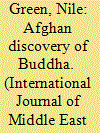

|
|
|
|
|
| Summary/Abstract |
Through their interactions with French archaeologists from around 1930, Afghan historians formulated a new official historical identity for Afghanistan based on its pre-Islamic past. This article provides the first analysis of this process by tracing the emergence of the new historiography through the career of its chief promoter, Ahmad ʿAli Kuhzad, as curator of the National Museum (founded 1931) and director of the Afghan Historical Society (founded 1942). Through placing Kuhzad in these official institutional settings and reading his major works, the article shows how traditional Persianate historiography was challenged by an imported and amended version of world civilizational history. In the decades after independence in 1919, this new historical vision allowed the young Afghan nation-state to stake its civilizational claims on an international stage. In these previously unexcavated historiographical strata lie the roots of the Taliban's iconoclasm, which are revealed as a dialogical response to the state cultural institutions that remade Afghanistan as Aryana.
|
|
|
|
|
|
|
|
|
|
|
|
|
|
|
|
| 2 |
ID:
173835
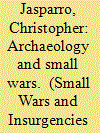

|
|
|
|
|
| Summary/Abstract |
The protection, destruction, utilization and manipulation of cultural property and material heritage, especially archaeological sites and artifacts, by state and non-state actors has become commonplace in contemporary small wars and hybrid conflicts. The U.S. and its western allies have taken a limited and largely legalistic and limited approach to this development in contemporary warfare to the advantage of adversaries who have made control of the past a key part of their strategies and operations. This paper traces the role of cultural heritage in small warfare from ancient times through its contemporary re-emergence and what the implications are for future small wars.
|
|
|
|
|
|
|
|
|
|
|
|
|
|
|
|
| 3 |
ID:
192897
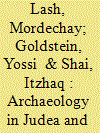

|
|
|
|
|
| Summary/Abstract |
This article examines the trends in archaeological research and the state of conservation of archaeological sites in Judea and Samaria between 1993 and 2022. The absence of Palestinian-Israeli cooperation resulted in the establishment of two parallel bodies that have been responsible for the issue, with no connection between them. In the Israeli-controlled territory, academic involvement declined with only a handful of new excavations. In the Palestinian-controlled territory, many new studies were conducted with foreign assistance, primarily to strengthen Palestinian national identity. An assessment of the state of conservation indicates significant damage as a result of development and antiquities theft. In this region, where the future remains uncertain, relics of the past and the research of these relics appear to have sustained irreversible damage.
|
|
|
|
|
|
|
|
|
|
|
|
|
|
|
|
| 4 |
ID:
101444
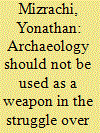

|
|
|
| 5 |
ID:
126873
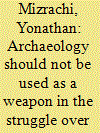

|
|
|
|
|
| Publication |
2011.
|
| Summary/Abstract |
The article presents the author's views concerning the political issue over the archaeological excavations and studies in Jerusalem. The author cites the decision of the city government to demolish 22 Palestinian dwellings in Silwan in order to construct the "Garden of the King" archaeological park. The author denotes how archaeology can mend the Israeli-Palestinian conflicts. The archaeology's implication on culture is also noted.
|
|
|
|
|
|
|
|
|
|
|
|
|
|
|
|
| 6 |
ID:
174322
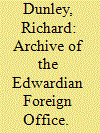

|
|
|
|
|
| Summary/Abstract |
This analysis explores the history and structure of the archive of the Edwardian Foreign Office. It uses data and quantitative research methodology to address two crucial questions. What survives within the collection? And what can historians and others find using the regular discovery tools such as indexes and catalogues? It concludes by looking at how these processes shape the ways historians are using this collection; and in doing so, it provides a crucial new context for any historians using this hugely important source and poses some challenging questions about the nature of archival research methodology.
|
|
|
|
|
|
|
|
|
|
|
|
|
|
|
|
| 7 |
ID:
180719
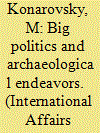

|
|
|
|
|
| Summary/Abstract |
LATE IN DECEMBER 1979, the Soviet Union moved troops into Afghanistan. The nearly decade-long presence of Soviet armed forces in Afghanistan in a bid to help the People's Democratic Party (PDPA) put its Utopian dream of building Soviet-modeled socialism into reality was a complicated and controversial period not only in Afghan but also in our own history, and it still receives mixed assessments.
|
|
|
|
|
|
|
|
|
|
|
|
|
|
|
|
| 8 |
ID:
183190
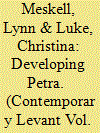

|
|
|
|
|
| Summary/Abstract |
This article charts the nascent development agendas for archaeological heritage and tourism at Petra in Jordan. We begin with the early internationalism of UNESCO and its participation programme for Petra followed by the restructuring of American foreign policy interests to embed heritage tourism within USAID projects. A technocratic tourism-as-assistance model galvanised USAID and the World Bank’s interest in Petra, as it did the CIA, the American Schools of Oriental Research, the US National Park Service, and Jordan’s Department of Antiquities. Thus, we reveal how saving Petra was underwritten by an increasing American vigilance in the Middle East. Unlike the educational and humanitarian components of the United Nations programme, the USAID and World Bank initiatives at Petra were almost exclusively directed toward tourism development, generating hard-currency revenue, monetising the Nabataean ruins, and sowing the seeds of predatory capitalism. Our longitudinal study reveals that what has been sustained at Petra is not the preservation of heritage, nor support for local communities, but rather an overburden of international bureaucracy and consultancy culture.
|
|
|
|
|
|
|
|
|
|
|
|
|
|
|
|
| 9 |
ID:
183982
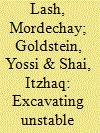

|
|
|
|
|
| Summary/Abstract |
This article examines the factors that influenced the trends in archaeological excavations in Judea and Samaria during the decade attending the 1967 Six-Day War. Examination reveals a close connection between the political trends in Israel as they pertained to Judea and Samaria and the archaeological excavations undertaken in this region. When a prime minister appeared to consider Judea and Samaria an inseparable part of the state of Israel archaeologists followed (Meir). But when prime ministers regarded Judea and Samaria as territory that would be returned to the Jordanians (Eshkol and Rabin), the archaeologists stopped excavating in the region.
|
|
|
|
|
|
|
|
|
|
|
|
|
|
|
|
| 10 |
ID:
076276


|
|
|
|
|
| Publication |
2006.
|
| Summary/Abstract |
The historiography of what is now the country of Laos has remained relatively underdeveloped since the colonial period. The earliest scholarly works produced by Lao and foreign authors were based on certain assumptions that have remained unquestioned despite serious problems with the sources. Recent epigraphical and archaeological discoveries have permitted a rethinking of these assumptions, and hold out the promise of further revisions of our view of the Lao past. Particularly worth exploring are the cultural and artistic connections between the Lao kingdom of Lan Xang and the northern Thai kingdom of Lanna.
|
|
|
|
|
|
|
|
|
|
|
|
|
|
|
|
| 11 |
ID:
114861
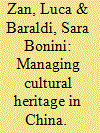

|
|
|
|
|
| Publication |
2012.
|
| Summary/Abstract |
This article investigates change processes regarding the managerial aspects of organizing cultural heritage activities in China. The focus is not on the historical and artistic meanings of archaeological discoveries in themselves; nor on the technical, scientific and methodological repercussions of conservation and restoration; nor on the evolution of museology per se. Rather, the core of the analysis is on new managerial problems along the "archaeological chain" (archaeological discoveries, restoration, museum definition and public access to cultural heritage) posed by new professional discourse and the overall evolution of the economic and political context. The article is based on field research carried out in Luoyang, Henan province. The micro view adopted (managing practices more than policies), and the unusual access to data (including financial figures on individual entities) represent a unique opportunity for a sort of "journey" inside the Chinese public sector.
|
|
|
|
|
|
|
|
|
|
|
|
|
|
|
|
| 12 |
ID:
178769
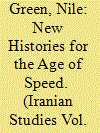

|
|
|
|
|
| Summary/Abstract |
By conceiving two emergent nation-states as a single region linked by conjoining roads, shared technologies and circulating researchers, this essay traces the emergence of a common “intellectual infrastructure” that during the interwar decades enabled European, American, Iranian, Afghan and Indian scholars to promote archeological and architectural interpretations of the Iranian and Afghan past. Taking Robert Byron’s Road to Oxiana as a fixed point of reference, the following pages survey the motor-linked sites where these new disciplinary approaches were developed and disseminated. By positioning Byron amid a larger cadre of investigators publishing in Farsi, Dari and Urdu no less than English, French and German, the essay shows how shifts in Iranian perceptions of the ancient and medieval past were part of a larger regional development, unfolding not only in familiar dialogue with Europe, but also in conversation and to some degree competition with nationalist scholarship in Afghanistan and India. Together with the journals, museums, learned societies and congresses which were launched in the 1920s and 1930s, cars and cameras—those key tools of the “age of speed”—were central to these learned ventures. Far from generating uniformity, this shared intellectual infrastructure enabled multiple interpretations of the archaeological and architectural past that were nonetheless mutually intelligible and methodologically consistent.
|
|
|
|
|
|
|
|
|
|
|
|
|
|
|
|
| 13 |
ID:
134421
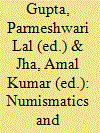

|
|
|
|
|
| Publication |
Nashik, Indian Institute of Research in Numismatics Studies, 1987.
|
| Description |
143p.Pbk
|
| Contents |
2nd International Colloquium
|
|
|
|
|
|
|
|
|
|
|
|
Copies: C:1/I:0,R:0,Q:0
Circulation
| Accession# | Call# | Current Location | Status | Policy | Location |
| 057921 | 737.4954/GUP 057921 | Main | On Shelf | General | |
|
|
|
|
| 14 |
ID:
187344
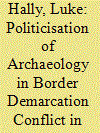

|
|
|
|
|
| Summary/Abstract |
Within contemporary developments of Asian regional security, a core undertone of conflict catalysts and motivations for territorial claims is directly motivated through archaeological findings. These findings include artefacts and settlements, which are utilised to justify political and territorial claims in the region. This overlooked factor will be analysed using three regional case studies through an archaeological and security studies lens. The research aims to further understand Asia Pacific regional security and political disputes and reflect conflict motivation undertones of each interacting nation-state. The article assesses core case studies of Chinese claims in the South China Sea, Japanese and Korean island claims, and Thai-Cambodian temple disputes. The research will analyse how site evidence becomes politicised to justify territorial claims in Asia- Pacific. Through interdisciplinary research, the article will conclude with a greater understanding of assessing conflict development and motivations between state actors in the Asia Pacific region.
|
|
|
|
|
|
|
|
|
|
|
|
|
|
|
|
| 15 |
ID:
173338
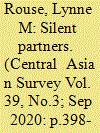

|
|
|
|
|
| Summary/Abstract |
Civilizations are as complex as the human relationships that engendered them, and outlining these relational qualities within open notions of mobility and interaction frames a reconceptualization of Central Asia’s past. Recent Eurasian archaeological research deconstructs deterministic political-economic or hierarchical typologies of civilization and the overly simplified narrative that roots it in urban centres perpetually juxtaposed with nomadic groups. Archaeological evidence from the Oxus Civilization, Central Asia’s earliest complex polity (ca. 2500–1400 BCE), reveals the deep roots of sedentary–mobile interactions. I argue that Oxus–steppe relationships helped maintain the long-term structural cohesion of the Oxus Civilization as a multicultural entity, with implications for subsequent Central Asian polities. As we begin to balance the lopsided conversations about the social formations of Central Asia’s past and present, the silent partnership that characterized the Oxus Civilization is given a voice that forces us to reconsider who, exactly, belongs inside our notions of civilization.
|
|
|
|
|
|
|
|
|
|
|
|
|
|
|
|
| 16 |
ID:
103129
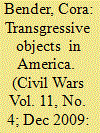

|
|
|
|
|
| Publication |
2009.
|
| Summary/Abstract |
Based on my own earlier theorising of 'mimesis at war', and taking up Simon Harrison's suggestion that trophies made from human body parts are best explained as 'transgressive objects', the article focuses on a particular trophy, a nineteenth century Cheyenne finger necklace. Its history illustrates that trophy-taking was part of a broader circulation of practices of war among native warriors and the American military in the West. Finally, trophy-taking made its way into the academic and scientific institutions that provide the discursive frame for present debates about war in anthropology and archaeology.
|
|
|
|
|
|
|
|
|
|
|
|
|
|
|
|
| 17 |
ID:
147867
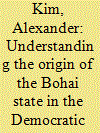

|
|
|
|
|
| Summary/Abstract |
The state of Bohai (on Korean reading – Parhae, 발해) existed in what is modern Russian Primorye region (Приморский край/Maritime Region), North Korea and Northeastern China, from the late seventh to the early tenth centuries AD. It played an important role in the history of the area as a major regional power for over two centuries. Recently, the history of Bohai has begun to attract scholarly interest. However, North Korean studies of Bohai remain basically almost unknown in the Western world. In this article, I present the history of Bohai studies in the Democratic People’s Republic of Korea (DPRK). In this article, I analyze not only North Korean studies of Bohai but also the opinions of the Korean scholars on the subject. They are rather specific for North Koreans who have unique access to the archaeological and historical materials on Bohai but are also subjected to unusually severe political pressures. The history of Bohai has now become an object of active political games which are related to territorial claims based on alleged archaeological and historical material. This situation increases the general interest in Bohai but also makes honest and unbiased research more difficult.
|
|
|
|
|
|
|
|
|
|
|
|
|
|
|
|
|
|
|
|
|